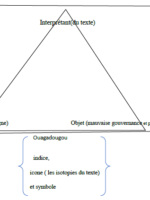Revue Hybrides (RALSH)
e-ISSN 2959-8079 / ISSN-L 2959-8060
Num. spécial 003, Oct. 2025
Impact of African American Slave Narratives on Contemporary Readers’ Empathy
Impact du Récit d’Esclaves Afro-américains sur le déclenchement de l’empathie chez les Lecteurs contemporains
Université Joseph Ki-Zerbo, Burkina Faso
Email : massiwok@gmail.com
Orcid id: https://orcid.org/0009-0003-1783-2479
Université Joseph Ki-Zerbo, Burkina Faso
Email : alexisnebie@gmail.com
Abstract: Slave narratives were one of the main forms of expression used by former African American slaves for denouncing the cruel nature of slavery. A key objective of these narratives was to elicit empathy from 19th-century readers, moving them emotionally and encouraging them to defend the plight of slaves. Despite being written centuries ago, our study investigates the impact that reading slave narratives can have on the empathy of contemporary readers, notably students at Université Joseph KI-ZERBO. This study draws simultaneously on Oatley et al. ‘s (2002; 2006; 2008;2013) theory of empathy as well as on Green et al.’s (2000) and Bal et al.’s (2013) theories of emotional transportation. The current research endeavors to discover whether readers become more inclined to empathy when reading about the atrocities depicted by Douglass in his 1845 slave narrative. An excerpt from this narrative containing scenes of violence against slaves is read by a sample of 50 students. The tool used to measure results before and after reading is Davis’s Empathic Concern Scale. The students’ degree of emotional absorption in the chosen narrative is measured using Green et al.’s emotional absorption scale. The analysis of the data provided allows our study to discover that reading Douglass’s slave narrative has a significant positive effect on the empathy of the readers studied. Readers’ engagement with slave narratives is therefore relevant in the present day, as it has great potential to stimulate empathy.
Keywords: Emotion, Empathy, Narratives, Slaves, Transportation.
Résumé: Le récit d’esclaves fut l’une des principales formes d’expression utilisée par les anciens esclaves afro-américains pour dénoncer la cruauté de l’esclavage. L’un des objectifs de ces récits était de susciter de l’empathie chez les lecteurs, de telle sorte que ceux-ci soient émus et enclins à défendre leur cause. Bien que ces récits soient écrits depuis des siècles, notre étude se penche sur l’impact que leur lecture peut avoir sur l’empathie des lecteurs contemporains, en l’occurrence les étudiants de l’Université Joseph KI-ZERBO. Pour se faire, elle s’appuie simultanément sur la théorie de l’empathie d’Oatley et al. (2002, 2006, 2008, 2013) et sur la théorie du transport émotionnel de Green et al. (2000) et de Bal et al. (2013). Plus précisément, cette recherche vise à déterminer si les lecteurs développent davantage d’empathie en lisant sur la violence dépeinte par Douglass dans son récit d’esclave. Un extrait de ce récit contenant des scènes de violences envers des esclaves est lu par un échantillon de 50 étudiants. L’outil de mesure des résultats avant et après lecture est l’échelle des préoccupations empathiques de Davis. Le degré d’absorption émotionnelle des étudiants dans le récit choisi est mesuré à l’aide de l’échelle d’absorption émotionnelle de Green et al. L’analyse des données permet de découvrir que la lecture du récit d’esclave a un effet positif significatif sur l’empathie des lecteurs étudiés. Ainsi, la lecture du récit d’esclaves par des lecteurs contemporains demeure pertinente car ayant un fort potentiel à stimuler en ceux-ci de l’empathie.
Mots-clé: Absorption, Émotions, Empathie, Esclaves, Récits.
Bibliography
Andrews, W. L. (1986). To Tell a Free Story: The First Century of Afro-American Autobiography, 1760–1865. University of Illinois Press.
Bal, P. M., Veltkamp, M. (2013). How does fiction reading influence empathy? An experimental investigation on the role of emotional transportation. PLoS ONE 8(1), 1-12, e55341.
https://doi.org/10.1371/journal.pone.0055341
Bruner, J. S. (1986). Actual minds, possible worlds. Harvard University Press.
Davis, M. (1980). A multidimensional approach to individual differences in empathy. Catalog of Selected Documents in Psychology, 10 (85), 2-19. https://www.uv.es/~friasnav/Davis_1980.pdf (Accessed on 19/06/2024)
Davis, M. (1983). Measuring individual differences in empathy: Evidence for a multidimensional approach. Journal of Personality and Social Psychology, 44(1), 113–126.
https://doi.org/10.1037/0022-3514.44.1.113
Davis, M. (1994). Empathy: A social psychological approach. Brown & Benchmark.
Djikic M, Oatley K, M.C. Moldoveanu. (2013). Reading other minds: Effects of literature on empathy. Scientific Study of Literature, Volume 3, Issue 1, 28-47. https://doi.org/10.1075/ssol.3.1.06dji.
Douglass F. (1995). Narrative of the Life of Frederick Douglass, An American Slave. Dover Publications.
Foster, F. S. (1994). Witnessing Slavery: The Development of Ante-bellum Slave Narratives. 2nd ed., University of Wisconsin.
Green, M. C., Brock, T. C. (2000). The role of transportation in the persuasiveness of public narratives. Journal of Personality and Social Psychology, 79 (5), 701-721. https://doi.org/10.1037/0022-3514.79.5.701
Gerrig, R. J. (1993). Experiencing narrative worlds: On the psychological activities of reading. Yale University Press.
Johnson, D. R. (2012). Transportation into a story increases empathy, prosocial behavior, and perceptual bias toward fearful expressions. Personality and Individual Differences, 52(2), 150–155.
https://doi.org/10.1016/j.paid.2011.10.005
Keen, S. (2006). A theory of narrative empathy. Narrative, 14(3), 207-236. https://doi.org/10.1353/nar.2006.001
Koopman, E., Hakemulder, F. (2015). Effects of literature on empathy and self-reflection: a theoretical-empirical framework. Journal of Literary Theory, 9(1), 79–111. DOI:10.1515/jlt-2015-0005
Mar, R. A., Oatley, K., De la Paz, J., Hirsh, J., Peterson, J. B. (2006). Bookworms vs. nerds: Exposure to fiction versus non-fiction, divergent associations with social ability, and simulation of fictional social worlds. Journal of Research in Personality, 40(5), 694–712. DOI: 10.1016/j.jrp.2005.08.002
Mar, R., Oatley, K., Peterson, J. B. (2009). Exploring the link between reading fiction and empathy: Ruling out individual differences and examining outcomes. Communications, 34(4), 407–428.
10.1515/COMM.2009.025
Mycoskie, B. (2011). Start something that matters. Spiegel and Grau.
Nell, V. (1988). The Psychology of reading for pleasure: Needs and gratifications. Reading research Quarterly, 23(1), 6-50. https://doi.org/10.2307/747903
Oatley, K. (1999). Why fiction may be twice as true as fact: Fiction as cognitive and emotional simulation. Review of General Psychology, 3(2), 101–117. https://doi.org/10.1037/1089-2680.3.2.101
Oatley, K. (2002). Emotions and the story worlds of fiction. In M. C. Green, J. J. Strange, and T. C. Brock (Eds.), Narrative impact: Social and cognitive foundations, 39-69.
file:///Users/massiwok/Downloads/Oatley2002Emosandstoryworlds.pdf. (Accessed on 03/10/2025)
Oatley, K., Keltner, D., Jenkins, J. M. (2006). Understanding emotions (2nd ed.). Blackwell.
Oatley, K., DjiKic, M. (2008). Writing as thinking. Review of General Psychology, 12(1), 9-27. https://doi.org/10.1037/1089-2680.12.1.9
Starling, M. W. (1981). The Slave Narrative: Its Place in American History. G.K. Hall and Co.
Wilkes, E. (2015). Hidden Slave Narratives: The Power of Teaching Empathy with Children’s Literature. Digital Literature Review, 2 (1), 94–105. https://doi.org/10.33043/DLR.2.0.94-105




